Magnetic Compass Was Invented In Ancient China
A. Sutherland - AncientPages.com - Magnetic compass is an indispensable navigation tool that has played a significant role in our history.
We find the first use of a magnetic compass in ancient China. The compass was invented as a divination tool by Chinese fortune-tellers who used the lodestones to construct their fortune telling boards. Eventually, they realized that the loadstones always pointed towards the north, and the truly practical use of the compass became reality.
There are allusions in the manuscript Wu Ching Tsung Yao, written in 1040, to “an iron fish” suspended in water that pointed to the south. And the earliest reference to a magnetic direction-finding device for land navigation is recorded in a Song Dynasty book dated to 1040-44.
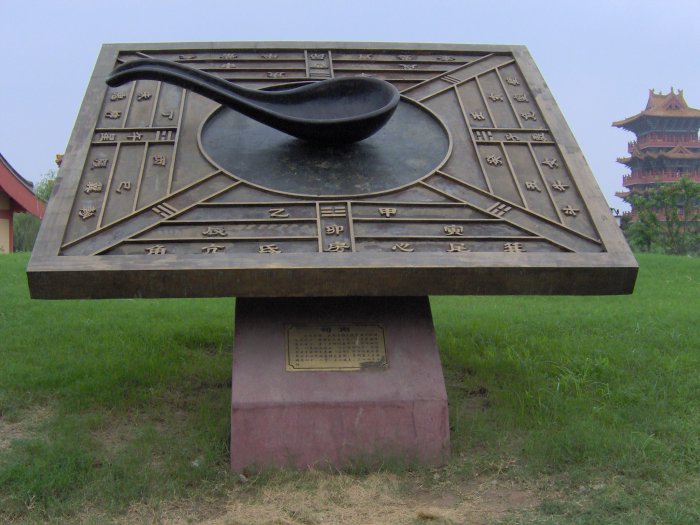
A model in Kaifeng of a Chinese ladle-and-bowl type compass used for geomancy in the Han Dynasty (202 BC – 220 AD).
The first “real” mention of the compass was in a book entitled “Dream Pool Essays” dated 1086 by scholar Shen Kuo, in the Song Dynasty.
Shen Kuo wrote that when “magicians rub the point of a needle with lodestone, then it is able to point to the south…It may be made to float on the surface of the water, but it is then rather unsteady…It is best to suspend it by a single cocoon fiber of new silk attached to the center of the needle by a piece of wax. Then, hanging in a windless place, it will always point to the south.”
See also:
Chinese Invention: World’s First Known Movable Type Printing
Highly Advanced Robots In Ancient China
Matches Were Invented In Ancient China.
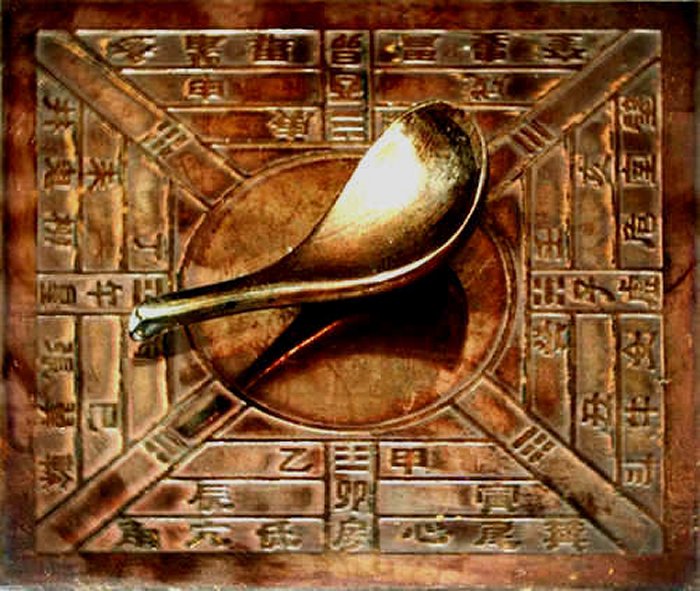
A Han dynasty magnetic compass, the needle is in the form of a carefully balanced ladle that points south.
The compass shows divisions for use in Feng Shui and Yi Jing.
In Europe, the magnetic compass first appeared in Amalfi, Italy, approximately in the 14th century but it is not known if the magnetic compass was invented in Europe or if it migrated to Europe along trade routes from China. However, it became very important for sea trade and military equipment and therefore it was more developed by Western nations.
With the successive rise of the Portuguese, Spanish, Dutch, and English empires, the development of the compass shifted to the European nations facing the Atlantic Ocean.
Before the age of the compass, ancient people used other navigation tools to cross the seas. According to sagas from the Viking era, the Vikings used whales, swells, birds, the stars, and the wind as clues to aid in navigation.
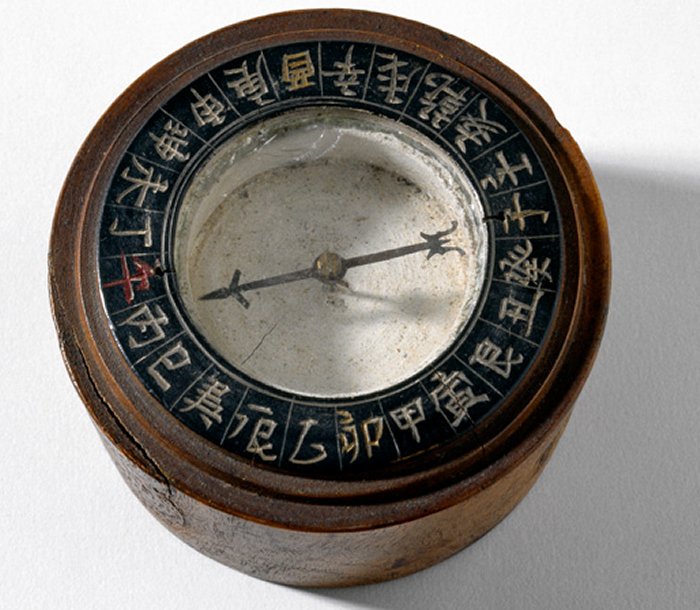
The compass was invented as a divination tool by Chinese fortune-tellers who used the lodestones to construct their fortune telling boards. Photo: SSPL/Getty Images/The Institute
The Norse sagas mention a mysterious “sunstone” – a magical stone that showed sailors the road when the sun disappeared. Today we call the stone – crystal stone of the Vikings.
The Phoenicians who were masters of sea travel covering great distances in their ships used costal and deep-sea navigation. They also depended on celestial navigation and built lighthouses.
Ancient Polynesian navigators used the sun, stars, sea swell patterns, cloud formations, and seamarks such as bird flight habits to traverse the waters and explore new lands.
Written by – A. Sutherland - AncientPages.com Senior Staff Writer
Copyright © AncientPages.com All rights reserved. This material may not be published, broadcast, rewritten or redistributed in whole or part without the express written permission of AncientPages.com
Expand for referencesMore From Ancient Pages
-
 A 19th-Century Sailing Ship Loaded With Champagne, Wine, Porcelain And Mineral Water Found At The Bottom Of The Baltic Sea
Underwater Discoveries | Jul 25, 2024
A 19th-Century Sailing Ship Loaded With Champagne, Wine, Porcelain And Mineral Water Found At The Bottom Of The Baltic Sea
Underwater Discoveries | Jul 25, 2024 -
 5,000-Year-Old Tavern With Food Remains Discovered In The Ancient Mesopotamian City Lagash
Archaeology | Feb 2, 2023
5,000-Year-Old Tavern With Food Remains Discovered In The Ancient Mesopotamian City Lagash
Archaeology | Feb 2, 2023 -
 Dolmen de Soto: Unique Millennia-Old Underground Structure Remains A Puzzling Enigma
Featured Stories | Feb 10, 2022
Dolmen de Soto: Unique Millennia-Old Underground Structure Remains A Puzzling Enigma
Featured Stories | Feb 10, 2022 -
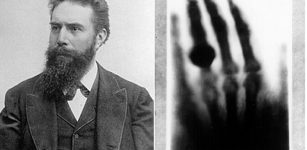 On This Day In History: Discovery Of X-Rays By Wilhelm Roentgen Reported – On Jan 5, 1896
News | Jan 5, 2017
On This Day In History: Discovery Of X-Rays By Wilhelm Roentgen Reported – On Jan 5, 1896
News | Jan 5, 2017 -
 First Odometer Was Invented By Vitruvius Around 15 BC
Ancient History Facts | Jan 24, 2016
First Odometer Was Invented By Vitruvius Around 15 BC
Ancient History Facts | Jan 24, 2016 -
 Mystery Of The Faceless Woman Found In A 1,000-Year-Old Royal Grave
Archaeology | Nov 7, 2023
Mystery Of The Faceless Woman Found In A 1,000-Year-Old Royal Grave
Archaeology | Nov 7, 2023 -
 Anqa: “Forgotten Twin” Of Dura-Europos Where Time Stood Still
Archaeology | May 9, 2024
Anqa: “Forgotten Twin” Of Dura-Europos Where Time Stood Still
Archaeology | May 9, 2024 -
 Mystery Of The Proto-Elamite Tablets – Cracking The World’s Oldest Undeciphered Writing
Artifacts | Oct 29, 2012
Mystery Of The Proto-Elamite Tablets – Cracking The World’s Oldest Undeciphered Writing
Artifacts | Oct 29, 2012 -
 Ancient Irish Practiced Special Burial Rituals Such As Dismemberment Of Bodies
Archaeology | Sep 18, 2017
Ancient Irish Practiced Special Burial Rituals Such As Dismemberment Of Bodies
Archaeology | Sep 18, 2017 -
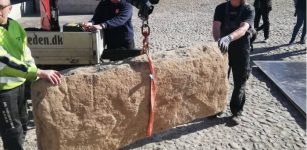 Huge Rare Runestone Found Under The Kitchen Floor In Randers Investigated
Archaeology | Jun 8, 2023
Huge Rare Runestone Found Under The Kitchen Floor In Randers Investigated
Archaeology | Jun 8, 2023 -
 Ancient Brewing And Natufian Rituals – What Came First, Beer Or Bread?
Archaeology | Sep 14, 2018
Ancient Brewing And Natufian Rituals – What Came First, Beer Or Bread?
Archaeology | Sep 14, 2018 -
 Massive 2nd-Century Fountain In Turkey’s Ancient City Of Tripolis Will Be Soon Restored
Archaeology | Aug 3, 2020
Massive 2nd-Century Fountain In Turkey’s Ancient City Of Tripolis Will Be Soon Restored
Archaeology | Aug 3, 2020 -
 ‘Bone Biographies’ Reveal Lives Of Medieval England’s Common People And Illuminate Early Benefits System
Archaeology | Dec 6, 2023
‘Bone Biographies’ Reveal Lives Of Medieval England’s Common People And Illuminate Early Benefits System
Archaeology | Dec 6, 2023 -
 Humans Lived In Rainforests At Least 150,000 Years Ago In Africa
Human Beginnings | Feb 27, 2025
Humans Lived In Rainforests At Least 150,000 Years Ago In Africa
Human Beginnings | Feb 27, 2025 -
 Impressive Gaulcross Hoard Reveals Secrets Of Mysterious Picts
News | Jun 20, 2016
Impressive Gaulcross Hoard Reveals Secrets Of Mysterious Picts
News | Jun 20, 2016 -
 Cousin-Marriages Were Uncommon In The Ancient World
Archaeology | Sep 14, 2021
Cousin-Marriages Were Uncommon In The Ancient World
Archaeology | Sep 14, 2021 -
 Ancient Society In The Sahara Desert Rose And Fell With Groundwater – Study
Archaeology | Oct 15, 2023
Ancient Society In The Sahara Desert Rose And Fell With Groundwater – Study
Archaeology | Oct 15, 2023 -
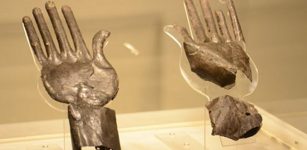 Mystery Of The Silver Hands Discovered In An Etruscan Tomb Full Of Secrets
Artifacts | Jun 12, 2015
Mystery Of The Silver Hands Discovered In An Etruscan Tomb Full Of Secrets
Artifacts | Jun 12, 2015 -
 Food In Ancient Roman Funerary Meals Was Similar To That Consumed During Life
Archaeology | Aug 30, 2022
Food In Ancient Roman Funerary Meals Was Similar To That Consumed During Life
Archaeology | Aug 30, 2022 -
 Odin: Norse God Of War And Magic – Most Complex Figure Of The Norse Pantheon
Myths & Legends | Oct 27, 2016
Odin: Norse God Of War And Magic – Most Complex Figure Of The Norse Pantheon
Myths & Legends | Oct 27, 2016
